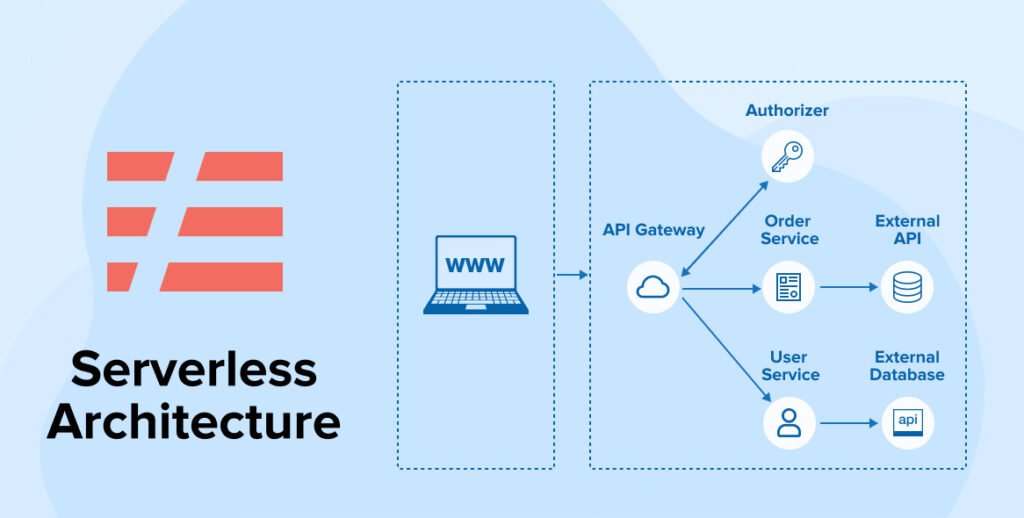Serverless architecture has revolutionized the way web applications are developed, deployed, and scaled. Contrary to what the name suggests, “serverless” doesn’t mean that there are no servers involved. Instead, it refers to the abstraction of server management, where developers no longer need to provision, scale, or manage the underlying infrastructure. Cloud providers take care of server maintenance, allowing developers to focus solely on writing code and delivering features.
In this blog post, we will explore what serverless architecture is, how it works, its benefits, and why web developers should consider adopting it for modern web development projects.
What is Serverless Architecture?
Serverless architecture is a cloud-computing execution model where the cloud provider dynamically manages the allocation of machine resources. With this approach, developers write functions that are executed in response to specific events, and the provider automatically handles the scaling and server allocation.
Key Concepts of Serverless Architecture:
- Functions as a Service (FaaS): Developers write stateless functions that run in response to triggers or events, such as HTTP requests or file uploads.
- Backend as a Service (BaaS): Instead of managing a backend, developers use third-party services to handle tasks like authentication, databases, and storage.
- Event-driven architecture: Serverless functions are typically triggered by events such as HTTP requests, file uploads, or database changes.
- Pay-per-use: Costs are based on the actual number of executions, making it a highly cost-effective option for applications with varying traffic loads.
Example Platforms for Serverless Computing:
- Amazon Web Services (AWS Lambda): One of the most popular serverless platforms where functions are executed in response to events.
- Google Cloud Functions: Google’s offering for serverless computing, integrating with other Google Cloud services.
- Microsoft Azure Functions: Azure’s solution that provides seamless integration with their cloud services.
How Serverless Architecture Works
In a traditional web application, developers would need to set up and manage servers, scale them as traffic increases, and handle patching and security updates. In a serverless model, developers simply deploy their functions to a cloud provider. When an event, such as an HTTP request, occurs, the provider executes the function, automatically scales it, and shuts it down when complete.
Workflow in Serverless Architecture:
- Write a function: Developers write a function in any supported language (e.g., Node.js, Python, Go).
- Trigger an event: Events such as an HTTP request, database update, or file upload trigger the function.
- Cloud provider runs the function: The cloud provider manages the infrastructure, spinning up the necessary resources to run the function.
- Function completes: Once the task is complete, resources are freed, ensuring there’s no idle cost.
Benefits of Serverless Architecture
1. Cost Efficiency
One of the main advantages of serverless architecture is that it operates on a pay-per-use model. You are only charged for the actual execution time of your functions, eliminating the cost of idle servers or unused resources. This makes it particularly beneficial for applications with varying levels of traffic.
2. Automatic Scaling
In traditional architectures, scaling often requires manual intervention, like adding more servers or adjusting load balancers. In serverless architecture, scaling is automatic and instant. When the number of requests increases, the cloud provider automatically scales the function to meet the demand, and when traffic decreases, it scales down accordingly.
3. Reduced Operational Complexity
Serverless architecture allows developers to focus on writing code rather than managing infrastructure. This reduces the operational overhead involved in provisioning, patching, and maintaining servers, allowing faster development cycles and less focus on infrastructure.
4. Faster Time-to-Market
With serverless architecture, developers can focus more on product features and less on infrastructure management. This enables faster development, testing, and deployment, accelerating time-to-market.
5. Better Resource Utilization
Since you only pay for what you use, serverless architecture ensures that resources are allocated efficiently. There’s no need to worry about over-provisioning or under-utilizing resources, making it an ideal choice for applications that experience sporadic or unpredictable traffic.
Use Cases for Serverless Architecture
Serverless architecture is highly versatile and can be used in various types of web development projects. Some common use cases include:
- Web APIs: Serverless is perfect for building lightweight RESTful APIs that respond to HTTP requests. Developers can set up an API Gateway that triggers Lambda functions in response to API requests.
- Microservices: Breaking down an application into small, independent functions allows for better scalability and flexibility.
- Data Processing: Serverless architecture can be used for processing large datasets, such as image manipulation, video transcoding, and log file processing.
- Real-time Applications: Serverless functions are great for real-time data processing, handling tasks such as sending notifications or updating dashboards.
- IoT Applications: In IoT systems, serverless architecture can be used to trigger functions when an IoT device sends data to the cloud, reducing latency and costs.
Challenges and Considerations of Serverless Architecture
While serverless architecture offers many advantages, it also comes with some challenges that developers should be aware of:
1. Cold Starts
Serverless functions experience a delay when they haven’t been invoked for some time, known as a “cold start.” This latency can impact applications where performance is critical, such as real-time systems.
2. Vendor Lock-In
Since serverless functions are highly dependent on specific cloud providers, migrating to another provider can be complex. It’s essential to consider how tightly your architecture is coupled to a provider’s ecosystem.
3. Debugging and Monitoring
Debugging serverless applications can be more complex than traditional applications, as you don’t have direct access to the server or underlying infrastructure. Developers need to rely on logs and monitoring tools provided by the cloud provider.
4. Limited Execution Time
Serverless functions typically have a limited execution time (e.g., AWS Lambda has a maximum execution time of 15 minutes). Long-running tasks might require alternative solutions, such as breaking them down into smaller functions or using other architectures.
Conclusion
Serverless architecture is a game-changer in modern web development, offering an efficient, cost-effective, and scalable solution for running applications in the cloud. By abstracting away server management, developers can focus on building functionality rather than dealing with infrastructure concerns.
While there are some limitations, the benefits of serverless, such as automatic scaling, cost efficiency, and reduced complexity, make it an attractive choice for many use cases. As serverless continues to evolve, it’s likely to become even more integral to the future of web development.
For expert guidance and custom serverless architecture solutions, visit TechsterTech to elevate your web development projects.



